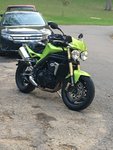Nice ride, Mike!
Could that be a late model (relatively) CB-750 behind the Wing, hiding under all the accessories and ornamentation and travel gear? Had a lot of fun on those back in the day. Owned five of them over the years, including one was a full hardtail chop. Great fun in Florida, hell on the kidneys in Vermont! And it didn't require a drip pan like the Harley chops (and the Beezer) do.
Cheers,
Wes
Could that be a late model (relatively) CB-750 behind the Wing, hiding under all the accessories and ornamentation and travel gear? Had a lot of fun on those back in the day. Owned five of them over the years, including one was a full hardtail chop. Great fun in Florida, hell on the kidneys in Vermont! And it didn't require a drip pan like the Harley chops (and the Beezer) do.
Cheers,
Wes


